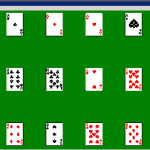Content Table:
Solitaire Game Guide
When people think of solitaire, they often think of one specific game. However, solitaire isn’t just a single game—it’s an entire category of card games designed to be played solo. The game most people recognize as “Solitaire” is actually called Klondike, the popular version that comes pre-installed with Microsoft Windows. But there’s much more to explore in the world of solitaire beyond just Klondike.
What is Solitaire?
Solitaire refers to any card game played alone, where the goal is usually to arrange cards in a specific order or clear them from the tableau according to set rules. The variety of solitaire games is staggering, and each has its own unique rules, strategies, and level of difficulty. Some of the most popular solitaire games include Freecell, Spider, Pyramid, and Tri Peaks.
Popular Solitaire Games
Klondike
The most iconic solitaire game, Klondike, is a blend of skill and luck. Not all cards are visible at the beginning of the game, making it a challenge to uncover and organize cards into sequences. This classic game has captivated players for years and is synonymous with the term “solitaire” for many.
Freecell
Another beloved solitaire game is Freecell. Unlike Klondike, all the cards are visible from the start, meaning there’s no luck involved—only strategy. Players must carefully plan their moves to ensure victory. Interestingly, out of the 32,000 deals available in Microsoft’s version of Freecell, only one—deal number 11982—is unsolvable. This makes Freecell a highly satisfying game for players who enjoy a logical challenge.
Spider
Spider Solitaire is a more difficult game, especially when played with four suits. In this version, players need to arrange cards in sequences from King to Ace within the same suit. Four-suit Spider can take up to half an hour of focused play to complete, making it a favorite among seasoned solitaire players who enjoy a real mental workout.
Pyramid
Pyramid is another visually distinctive game. The cards are laid out in a pyramid shape, and the player must remove pairs of cards that add up to 13. The challenge increases as the player works to clear the lower levels and reach the cards at the top of the pyramid.
Tri Peaks
Tri Peaks is a variation of Pyramid, where the cards are laid out in three connected peaks. The goal is to move cards to the foundation by creating sequences either in ascending or descending order. This game is known for being quick and fun, making it ideal for casual play.
Solitaire Game Styles: A Mix of Luck and Strategy
One of the fascinating aspects of solitaire is the variety of gameplay styles. Some games, like Klondike, rely on a combination of luck and skill. Players don’t start with all the information, as many cards remain face-down, so they must balance calculated moves with an element of chance.
On the other hand, games like Freecell present all the cards at the start, making them entirely skill-based. There’s no luck involved—if you think carefully enough and plan ahead, you can solve nearly every deal. This appeals to players who prefer games where they can rely solely on strategy.
Then there are games like Spider Solitaire that are incredibly challenging, especially in the four-suit version. These games test players’ patience and strategic thinking, requiring them to make the right moves at the right time to win.
Solitaire for Every Skill Level
Solitaire games vary in difficulty, which makes them accessible to players of all skill levels. Beginners might enjoy easy games like Clock, which don’t require much thinking, while experienced players can take on more difficult games like Four-Suit Spider, which demands deep concentration and problem-solving.
Beyond difficulty, many solitaire games also feature unique and attractive layouts. For example, in Pyramid, the cards are arranged in a pyramid shape, and in La Belle Lucie, the cards are spread out into fans that shrink and grow as the game progresses. These distinct layouts add an extra layer of enjoyment to the games, particularly for those who appreciate both the strategic and aesthetic elements of solitaire.
Historical Significance of Solitaire
Did you know that solitaire was a favorite pastime of some historical figures? It’s said that George Washington and Napoleon Bonaparte both played a version of solitaire called Napoleon at Elba, which helped them think through stressful situations. This connection between solitaire and strategic thinking isn’t surprising—many solitaire games require deep concentration and careful planning, making them both fun and mentally stimulating.
The Benefits of Playing Solitaire
Beyond being a fun way to pass the time, solitaire offers several mental benefits:
- Improves Concentration: Many solitaire games require players to focus intently on the board and think several moves ahead.
- Enhances Memory: Remembering the positions of face-down cards or strategizing based on the visible cards can help improve short-term memory.
- Reduces Stress: Despite the mental effort involved, solitaire can be a relaxing and satisfying way to unwind, offering a break from the fast-paced distractions of modern life.
Conclusion: Explore the World of Solitaire
No matter what mood you’re in or how much time you have, there’s a solitaire game for you. Whether you prefer the quick satisfaction of Tri Peaks or the strategic depth of Freecell, solitaire offers endless hours of entertainment and mental stimulation. I encourage you to try a solitaire game package and discover for yourself just how much fun the solitaire universe can be. It’s a timeless way to relax, think, and enjoy some quiet time away from the hustle and bustle of life.



